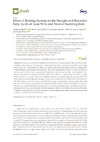Please use this identifier to cite or link to this item:
https://accedacris.ulpgc.es/handle/10553/71855
| DC Field | Value | Language |
|---|---|---|
| dc.contributor.author | Ripoll, Guillermo | en_US |
| dc.contributor.author | Alcalde, María Jesús | en_US |
| dc.contributor.author | Argüello Henríquez, Anastasio | en_US |
| dc.contributor.author | Córdoba, María De Guía | en_US |
| dc.contributor.author | Panea, Begoña | en_US |
| dc.date.accessioned | 2020-04-30T10:08:45Z | - |
| dc.date.available | 2020-04-30T10:08:45Z | - |
| dc.date.issued | 2020 | en_US |
| dc.identifier.issn | 2304-8158 | en_US |
| dc.identifier.other | Scopus | - |
| dc.identifier.uri | https://accedacris.ulpgc.es/handle/10553/71855 | - |
| dc.description.abstract | Goat meat is considered healthy because it has fewer calories and fat than meat from other traditional meat species. It is also rich in branched chain fatty acids that have health advantages when consumed. We studied the effects of maternal milk and milk replacers fed to suckling kids of four breeds on the straight and branched fatty acid compositions of their muscle. In addition, the proximal and fatty acid compositions of colostrum and milk were studied. Goat colostrum had more protein and fat and less lactose than milk. Goat milk is an important source of healthy fatty acids such as C18:1 c9 and C18:2 n-6. Suckling kid meat was also an important source of C18:1c9. Dairy goat breeds had higher percentages of trans monounsaturated fatty acids (MUFAs) and most of the C18:1 isomers but lower amounts of total MUFAs than meat breeds. However, these dairy kids had meat with a lower percentage of conjugated linoleic acid (CLA) than meat kids. The meat of kids fed natural milk had higher amounts of CLA and branched chain fatty acids (BCFAs) and lower amounts of n-6 fatty acids than kids fed milk replacers. Both milk and meat are a source of linoleic, á-linolenic, docosahexaenoic, eicosapentaenoic and arachidonic fatty acids, which are essential fatty acids and healthy long-chain fatty acids. | en_US |
| dc.language | eng | en_US |
| dc.relation.ispartof | Foods | en_US |
| dc.source | Foods [ISSN 2304-8158], v. 9 (4), (Abril 2020) | en_US |
| dc.subject | 310101 Productos lácteos | en_US |
| dc.subject.other | Bcfa | en_US |
| dc.subject.other | Colostrum | en_US |
| dc.subject.other | Goat | en_US |
| dc.subject.other | Methyl | en_US |
| dc.subject.other | Milk | en_US |
| dc.subject.other | Replacer | en_US |
| dc.title | Effect of rearing system on the straight and branched fatty acids of goat milk and meat of suckling kids | en_US |
| dc.type | info:eu-repo/semantics/Article | en_US |
| dc.type | Article | en_US |
| dc.identifier.doi | 10.3390/foods9040471 | en_US |
| dc.identifier.scopus | 85083301620 | - |
| dc.contributor.authorscopusid | 23968109200 | - |
| dc.contributor.authorscopusid | 7003518858 | - |
| dc.contributor.authorscopusid | 6701710018 | - |
| dc.contributor.authorscopusid | 7005697475 | - |
| dc.contributor.authorscopusid | 6602659752 | - |
| dc.identifier.eissn | 2304-8158 | - |
| dc.identifier.issue | 4 | - |
| dc.relation.volume | 9 | en_US |
| dc.investigacion | Ciencias de la Salud | en_US |
| dc.investigacion | Ciencias | en_US |
| dc.type2 | Artículo | en_US |
| dc.description.numberofpages | 19 | en_US |
| dc.utils.revision | Sí | en_US |
| dc.date.coverdate | Abril 2020 | en_US |
| dc.identifier.ulpgc | Sí | en_US |
| dc.contributor.buulpgc | BU-VET | en_US |
| dc.description.sjr | 0,774 | - |
| dc.description.jcr | 4,35 | - |
| dc.description.sjrq | Q1 | - |
| dc.description.jcrq | Q2 | - |
| dc.description.scie | SCIE | - |
| item.grantfulltext | open | - |
| item.fulltext | Con texto completo | - |
| crisitem.author.dept | GIR IUSA-ONEHEALTH 4. Producción y Biotecnología Animal | - |
| crisitem.author.dept | IU de Sanidad Animal y Seguridad Alimentaria | - |
| crisitem.author.dept | Departamento de Patología Animal, Producción Animal, Bromatología y Tecnología de Los Alimentos | - |
| crisitem.author.orcid | 0000-0002-4426-0678 | - |
| crisitem.author.parentorg | IU de Sanidad Animal y Seguridad Alimentaria | - |
| crisitem.author.fullName | Argüello Henríquez, Anastasio | - |
| Appears in Collections: | Artículos | |
SCOPUSTM
Citations
14
checked on Jun 8, 2025
WEB OF SCIENCETM
Citations
15
checked on Jun 8, 2025
Page view(s)
61
checked on May 11, 2024
Google ScholarTM
Check
Altmetric
Share
Export metadata
Items in accedaCRIS are protected by copyright, with all rights reserved, unless otherwise indicated.
